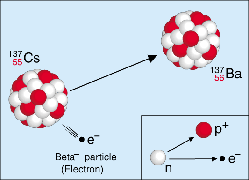PointThe point of these experiments is to see which radiation which have the longest range and highest intensity. It’s also an experiment which shows us how much resistance they can fly through.
Materials:
Alfa-, Beta-, and Gamma sources. Geiger tube and counter. Profile track with two riders. A ruler. Absorb set with different plates with different sizes. Other things like paper.
Experiment 1:
We started with the Alfa-source. We placed it in one of the riders and in the opposite rider we placed the Geiger tube, which was connected to a Geiger counter. We placed the Alfa-source close to the Geiger tube. Then we turned on the Geiger counter and heard really many beeps (which means that the intensity is high). Then we took the rider with the Alfa-source and moved it further from the Geiger tube. When the rider was moved a bit the beeps became less.
We removed the Alfa-source from the rider again and placed the Beta-source in the rider. We turned off the Geiger counter and moved the Beta-source rider close to the Geiger tube again. We turned on the Geiger counter again and heard many beeps but not as many as the Alfa-source. We moved the rider with the Beta-source further from the Geiger counter again and this time we noticed that there still were many beeps in a longer range than before.
We removed the Beta-source from the rider again and placed the Gamma-source. We turned off the Geiger counter and moved the Gamma-source close to the Geiger tube. Then we turned on the Geiger counter again and heard medium numbers of beeps. Then we started to move the Gamma-source further from the Geiger tube and this time we noticed and were very surprised that the beeps stopped between where the Alfa- and Beta-sources’ beeps stopped. Our teacher has told us that this experiment had been a failure. The Gamma-source was suppose to last much longer than the Beta-source. It was ought to sound like that the beeps still were intact when the Gamma-source was very far away.
Experiment 2:
We started with the Alfa-source and pointed it towards the Geiger tube. We put a paper between but it didn’t have any effect so we folded the paper once. It still didn’t have effect so we kept folding. The beam first got weakened when we had folded the paper three times and then had 8 layers of paper.
Then we tried with the Beta-source and we saw that paper didn’t had any effect at all. We tried therefore with some thicker aluminium-plates. The beam got weakened when 2 mm aluminium hang between the Beta-source and the Geiger tube. We saw a clear change. The Beta-source was obviously more persistent than the Alfa-source.
Then it became the Gamma-source’s turn. Here we had to adopt a tough stance. Neither paper or aluminium had any effect. The intensity first started dropping when we used lead. When the beam finally got weakened 1,5 cm of lead, 1 cm of aluminium and 32 layers of paper hang as brakes.
Theory:
If we have an arm, Alfa-radiation will stop on the skin, while Beta-radiation stops inside the arm and finally Gamma-radiation doesn’t stop. It flies right through the arm. These sources are radioactive.
The decay-process for the 3 radiations:
The actual Alfa-radiation is (we can take Radon as an example) when Radon transmits a Helium-core (consisting of two protons and two neutrons) because of it’s unstability. When Radon has transmitted the Helium-core (Alfa-particle), it becomes the element named Polonium.

Beta-radiation often starts because the nucleus is unstable (it has too many neutrons). Therefore the nucleus emit an electron (a Beta-particle) and now the nucleus transforms a neutron to a proton. The nucleus is positive and because it has got a proton more, it changes into the element just above it in the periodic table (if it was number 55 before, then it is number 56 now. It had got and extra proton and the numbers of protons correspond to the element’s number in the periodic table).
Caesium gains a proton and transforms into Barium while it emits an electron.
 The gamma-radiation is pure energy. When a atomic nucleus splits (fission), it releases a lot of energy, that's called gamma-radiation.
The gamma-radiation is pure energy. When a atomic nucleus splits (fission), it releases a lot of energy, that's called gamma-radiation. In our daily life radioactive radiation is nothing we should be afraid of. We have in fact a radioactive isotope of Kalium in our body. Background radiation is mostly coming from the sky or the earth and isn’t dangerous either. It’s in tiny amounts so we are not affected by it, even though it hits us every day. If a power station explodes, thousands of radioactive matters flies out in our atmosphere and can be carcinogenic or deadly.
Konklusion:
We found out that Alfa-radiation had a short range but a very high intensity close up. Beta-radiation had a not quite as intense radiation but it had a longer range than Alfa-radiation. Gamma-radiation had the longest range. It was not that intense but it was almost unstoppable. Gamma is pure energy/electromagnetic radiation so it doesn’t react like the others. The Alfa-particle is the biggest (It consists of a Helium-core (two protons and two neutrons and the core is positive)) it weighs 4 unit. The Beta-particle is the smallest. It consists of an electron and is therefore negative. It weighs 1/2000 of a unit.
We proved that the Alfa-particle is the biggest given that we could stop it with something as thin as paper. We proved that the Beta-particle was smaller given that it could fly through much more robust materials.
By Frederik og Christian 9.A
No comments:
Post a Comment